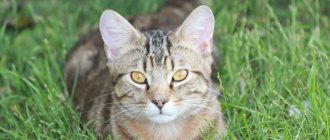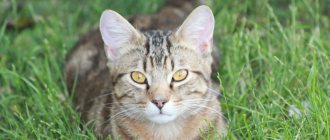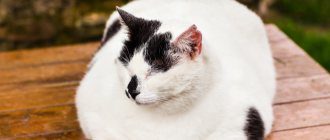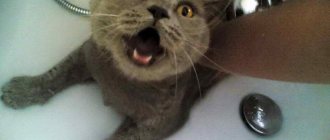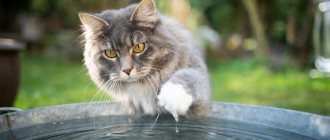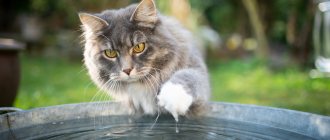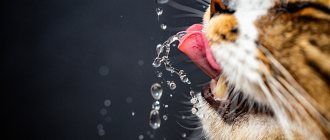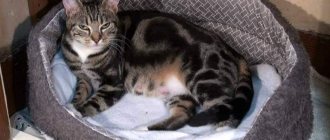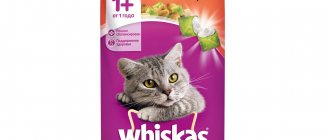Pet owners are always happy to see their pets healthy, well-groomed and in a good mood. But our four-legged friends, just like people, can get sick. Long-term refusal of food or water is the first sign of some changes in the body or illness.
Cat at the doctor
And we, the people responsible for the lives of our pets, try to do everything possible to keep them healthy. Our smaller brothers do not have speech like people. They cannot tell where and what hurts them. Therefore, help must be immediate.
Nutrition and fluid standards for cats.
The breeder decides what to feed the cat. There are several food options:
- Dry food.
Cat and dry food
- Wet. They sell bags or so-called pouches of food. This group includes canned cat food.
Wet food
- Combined. This is when they alternate between dry and wet.
- Natural food. There is a certain percentage of breeders who prefer to feed natural food, for example: cottage cheese, cereals, eggs, fish, meat.
Natural food
A cat's daily intake of food and water depends on several factors:
- Age.
As a rule, newborn kittens up to 6 months of age require frequent feeding 3-4 times a day.
Grown-up kittens up to one year old are given food 2-3 times a day.
Adult cats are given food 1-2 times a day.
For older pets who are healthy, once a day is enough.
- Health status.
For example, if a cat has recently given birth to kittens or is in an interesting situation, you should feed more and more often for obvious reasons. Milk should contain as many nutrients and vitamins as possible for newborn babies.
Cat feeding kittens
After operations: castration and sterilization, the menu should be given more attention. Since metabolism slows down, pets are prone to weight gain.
Cat after sterilization
- Breed.
Large breed cats such as Maine Coon, Kurilian Bobtail, Norwegian Forest, and Ragdoll eat more food per day.
Typically, adult cats weigh between 3-5 kg.
If the pet's ribs are visible in a calm state, this indicates that the diet is incorrect and it needs more food.
Now a little about water balance.
There should always be enough fresh drinking water. This is especially true for those cats who consume dry food. The water bowl does not need to be placed next to the bowl where the cat's food is. Put it somewhere else. Our smaller brothers are very smart animals, and often rely on instincts. The fact is that in the wild, a cat does not leave its food near water, for example, near a lake or river, because food tends to rot and decompose.
Have you noticed that cats love to drink tap water?
There is an explanation for this. Pets believe that this water is cleaner than in a bowl because stagnant water is rich in germs and contaminants. Wash food and water bowls regularly, as unfavorable microflora accumulate there.
Cat and water
Lack of water leads to urolithiasis. The kidneys and liver suffer. Therefore, provide your pets with clean drinking water. Better filtered.
Final thoughts
As a reminder, whenever your cat is not eating or drinking, you should take her to the vet as soon as possible. This is especially true if your cat isn't getting any fluids at all. Dehydration can have detrimental effects on your cat, even if the underlying condition is treatable.
So, encourage your cat to eat whatever food you can. Contact your veterinarian immediately. And don't wait until it's too late. Your cat depends on your judgment and quick action.
Posted by Christian Adams An American expat living in Metro Manila, Philippines for over a decade, Christian is a lifelong cat lover and the proud father of two rescue cats, Trixie and Chloe. Both girls used to be among the crowds of homeless people who roam the cities and countryside. Three-year-old Trixie was rescued from a litter found under a neighbor's porch, and two-year-old Chloe was brought home by Christian's young son, Henry, who discovered the crying kitten in the parking lot.
How does hunger affect the body?
Everyone has probably seen stray dogs and cats on the street. Their appearance is often frightening, thin, with protruding bones and sunken eyes.
stray cat
Please note that the digestive systems of dogs and cats are different. Dogs are relatives of wolves and their bodies are adapted to fasting for a large amount of time. But things are different for cats. Felines eat often and in small portions, so when there is a lack of food, the body experiences great stress. It is known that fat is broken down in the liver. If food is not supplied for a long time, the liver will process more fat. And she will no longer cope with such a load. This will give rise to the development of diseases. The kidneys and liver are primarily affected. And if the refusal to eat drags on for a long time, then nutritional dystrophy occurs, in other words, depletion of the body from which all organs, without exception, suffer.
We identify the causes of fasting
Refusal to eat does not always signal that your pet is not feeling well.
Sometimes cats fast for 24 hours as a way to fasten their diet. Here are a number of reasons why a cat may refuse food:
- Stress. Losing an owner, moving to another place, meeting other pets, for example, you got another cat or dog.
- Acclimatization. Let's say you took your pet on vacation. Usually the hunger strike lasts no more than 2 days.
- Abrupt transfer from one food to another. Or, for example, introducing a new product into the diet.
- Poisoning.
- Operation. After any surgical medical intervention performed under anesthesia. Animals recover from anesthesia for at least a day.
- Hormonal changes in the body. Estrus, mating, pregnancy, childbirth.
- A hunger strike can be triggered by a tick bite.
- Disease. Lethargy, refusal of food and even water, a common symptom of a hidden disease or inflammatory process.
- Lack of sanitary standards. Dishes and feeding area should always be clean.
- Oral disease. Cats also have tooth and gum pain. Moreover, there may be a foreign object in the mouth, for example, a fish bone. As well as the appearance of cones and formations. Only a doctor can determine whether a tumor is malignant or not.
Signs of dehydration
If there is nothing alarming about the owner’s pet’s behavior or state of health, then he will not follow him around to observe how often and in what volume he drinks water. This is where the danger lies. If an animal voluntarily refuses to drink, this is not immediately detected, which is why the pet develops dehydration.
When this pathological condition appears, which is dangerous both for the health and life of the cat, a certain symptomatic picture arises. The intensity of signs of dehydration increases rapidly. Dehydration in cats is indicated by:
- Gradual decrease in the animal’s motor activity. This is especially noticeable in those pets who were previously active and playful, but now spend most of their time lying down.
- Prolonged constipation.
- Saliva that becomes too viscous and sticky.
- Rare urge to urinate, decreased urine volume. In severe cases, the animal stops going to the toilet altogether.
- Decreased body temperature. For cats, a normal temperature is considered to be from +37 to +38°C. But as dehydration develops, this figure decreases; the pet’s body temperature can drop to 36.5°C or less.
- Increased pulse and heart rate.
- Dry, pale gums and oral mucosa.
- Dull eyes that can “sink.”
- Deterioration in the condition of the coat - it begins to rapidly fall out, often in whole clumps, loses its shine and color, becomes dull and faded.
If you detect at least 1-2 of the above signs, you should immediately contact a veterinarian. Dehydration leads to total pathological changes in the animal's body. It will not be possible to cope with them just by forcefully pouring water into the oral cavity; complex drug therapy with shock doses of vitamins and nutrients is required.
Consequences of not eating
Here are a few factors that influence the consequences of not eating and drinking:
- Age of the cat;
- Weight;
- Causes and duration of hunger;
- Health status.
But look at the consequences of long-term abstinence from cat food:
- Weight loss.
- Prostration. It is difficult for the cat to get up and move around. If she moves, it is very slowly and not confidently.
- Hair loss, mats.
- Visual acuity is lost.
- Constipation, kidney failure, gastric ulcers.
When should you worry?
An animal's refusal to eat is an alarming symptom, and if present, it is necessary to visit a veterinarian.
If an animal does not want to eat or drink, and when you try to force feed it, it spits it out, this is a bad signal. Signs that a cat is sick are a warm and dry nose, high fever, nausea, vomiting, diarrhea, weakness and lethargy, loss of appetite and desire to drink water. This condition can be caused by poisoning or infections. Any owner should be wary of this. You need to consult a specialist as soon as possible.
How long can a cat live without water?
Everyone knows the fact that almost every living thing on the planet consists of water. For example, a person consists of 80% water, but cats are 70%. The average fluid intake for an adult cat is 200-300 ml per day.
Water performs important functions in a cat's body:
- Regulates body temperature.
- Necessary for normal digestion of food.
- Removes toxins from the body.
- Supports Organ Functions
- Ensures the functioning of enzymes.
Several factors influence life expectancy in the absence of water:
- Season. In unbearable heat and stuffiness, cats can live no more than a day, if they are lucky, a day and a half. Accordingly, in the cold season, this period will increase slightly.
Cat in the shadows
- Cat food. If you feed your pet exclusively dry food, dehydration will occur very quickly.
- Breed. For example, British breed cats consume less fluid than other breeds.
Important! For cats, the lack of food is not as critical as the lack of water.
If you are forced to leave your pet alone for several days, provide constant access to water. You can place water in different parts of the apartment. As a last resort, leave the toilet lid open.
Pet stores sell automatic waterers for pets. They will provide regular access to water.
Water bowl for cats
Video “How to feed a cat what he doesn’t eat”
The owner in the video prepares fruits and vegetables for her pet and feeds them to the cat.
Was this article helpful?
Thank you for your opinion!
The article was useful. Please share the information with your friends.
Yes (50.00%)
No (50.00%)
X
Please write what is wrong and leave recommendations on the article
Cancel reply
Rate the benefit of the article: Rate the author ( 4 votes, average: 4.50 out of 5)
Discuss the article:
First aid
If it is not possible to visit a doctor. Or you need a long time to go to the veterinary clinic, then you can try to restore your appetite yourself:
- Older cats lose their sense of smell as they age. Bring the bowl close to your nose.
- Try giving a treat that your cat has never refused.
- Warm up the food, put a small amount in your palm and bring it close to the cat.
- Pet stores sell medications that induce appetite.
